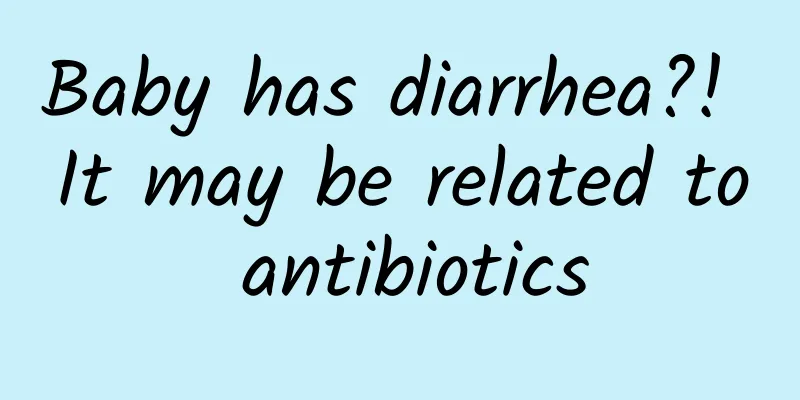Baby has diarrhea?! It may be related to antibiotics

|
I believe everyone is familiar with antibiotics, but some babies may have diarrhea after taking antibiotics. We call this kind of diarrhea that occurs with the use of antibiotics and cannot be explained by other reasons antibiotic-associated diarrhea (AAD). Which antibiotics are likely to cause AAD? The incidence of AAD is related to the antibiotics used. Studies have shown that, except for vancomycin and aminoglycoside antibiotics, most antibiotics can cause AAD. This is especially true for antibiotics whose antibacterial spectrum covers intestinal anaerobic bacteria and have high concentrations in the intestinal cavity [1]. Cephalosporins, broad-spectrum penicillins, amoxicillin, etc. have a higher risk of causing AAD, and the more types of antibiotics used and the longer the time, the higher the risk of AAD. Which babies are prone to AAD? The incidence of AAD is also closely related to the baby's own factors. Previous AAD epidemiological studies have shown that younger, malnourished, and immunocompromised babies are more likely to develop AAD. Poor basic conditions, surgery, and the use of gastrointestinal motility drugs and proton pump inhibitors can also lead to an increased incidence of AAD [2]. Why do babies develop AAD? AAD in babies is usually divided into two categories: non-infectious and infectious, depending on whether pathogens are involved. Non-infectious AAD can also be called functional AAD, and its main causes are the direct effect of antibiotics and the destruction of normal intestinal flora caused by the use of antibiotics. Infectious AAD is mainly caused by antibiotics causing intestinal flora imbalance, destruction of normal flora, and over-growth of conditional pathogens, leading to diarrhea of varying degrees of severity. The main pathogen that causes infectious AAD is Clostridium difficile. Related studies have shown that diarrhea caused by Clostridium difficile accounts for 10%-25% of AAD. If your baby has AAD, how should it be treated? 1) Antibiotics should be discontinued or replaced; 2) Antibiotic treatment: Metronidazole can be given to patients with mild or moderate C. difficile AAD, and vancomycin can be given to patients with severe C. difficile AAD or those who do not respond well to metronidazole. 3) Symptomatic supportive treatment, including symptomatic fluid replacement, correction of water and electrolytes, etc.; 4) Intestinal flora regulation therapy: Some clinical trials have confirmed that Lactobacillus casei and Lactobacillus rhamnosus can be used to treat AAD[3]. In order to avoid the occurrence of AAD, how should we prevent it? 1) Do not abuse antibiotics and avoid frequent changes of antibiotics; 2) Try to choose drugs that have less impact on intestinal flora; 3) The use of microecological preparations can prevent AAD. Probiotics such as Bifidobacterium and Lactobacillus can reduce the incidence of AAD [4]; 4) Avoid giving your baby any examinations or treatments that may damage their intestines as much as possible. In recent years, the incidence of antibiotic-associated diarrhea has become increasingly high. Severe diarrhea can cause dehydration, acid-base imbalance, and electrolyte imbalance in babies. Therefore, mothers must pay great attention to not use antibiotics on their children as soon as they have a fever or a cold. They must go to a regular hospital for relevant examinations and then select antibiotics in a targeted manner according to the doctor's diagnosis and doctor's advice. References [1]Bergogne-Bérézin E. Treatment and prevention of antibiotic associated diarrhea [J]. Int J Antimicrob Agents, 2000, 16(4): 521-526. [2]Elseviers MM, van Camp Y, Nayaert S. Prevalence and management of antibiotic associated diarrhea in general hospitals [J]. BMC Infect Dis, 2015, 15: 129. [3]McFarland LV. Evidence-based review of probiotics for antibiotic-associated diarrhea and Clostridium difficile infections[J]. Anaerobe, 2009, 15(6):274-280. [4]Issa I, Moucari R. Probiotics for antibiotic-associated diarrhea: Do we have a verdict?[J]. World J Gastroenterol, 2014, 20(47): 17788-17795. (Li Jinshi, Changchun Children's Hospital) |
<<: Eat 8,400 bacteria in one bite? A must-eat food in summer nearly killed a family of three!
>>: There are so many things to pay attention to when injecting insulin. Are you doing it right?
Recommend
5 week fetus picture
At this time, the fetus grows to 0.4cm and looks ...
What happens if you eat motherwort during pregnancy?
We all know that motherwort has a good effect on ...
What should I do if I have a urinary tract infection during a normal delivery?
The old people say that women must give birth nat...
Trichomonas pictures
Trichomoniasis is a general term for diseases cau...
Can I drink hot and sour soup during menstruation?
Many women are very confused about what they can ...
The deadly toxin "fumonisin" in cold noodles, in what other foods is it hidden?
Recently, the news that one woman died and the ot...
Does pomelo have a red heart? When is pomelo the sweetest?
Wen Dan, also known as Yuhuan Pomelo, is flat-sph...
What causes a woman's vagina to turn black?
The color of a woman's private parts is a pri...
How to treat vulvar leukoplakia?
Generally, patients with vulvar leukoplakia often...
Can I drink Isatis Root Granules while breastfeeding?
Isatis root powder is very common in daily life. ...
Uterine pain after transplant
In vitro fertilization requires embryo transfer. ...
How are carotid artery plaques formed? Can ultrasound determine the hardness of plaques?
Author: Chief Physician, Huayang Capital Medical ...
What is the biggest problem of not eating staple foods to lose weight? Be careful not to get fatter!
Recently, I saw a report in the news again about ...
Brown discharge at 10 weeks pregnant
If brown discharge appears at ten weeks of pregna...
How to treat adenomyosis? These four must be done
Adenomyosis is a common uterine disease and also ...









